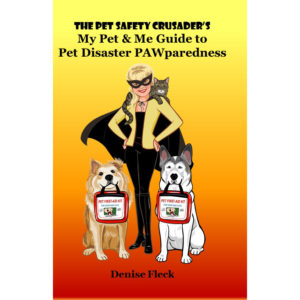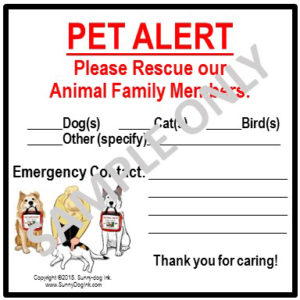
In 2009, the American Kennel Club and ADT Security got together to launch National Pet Fire Safety Day! Since then, it has taken place every year on July 15, and it’s a day to learn how to keep your pet safe in a fire. For all of you reading this blog I am sure, pets are our most precious blessing, so it makes sense that we’d want to learn how to keep them safe during one of the scariest things imaginable: a house fire!
Every year, 500,000 dogs and cats are affected by house fires and about 40,000 of them die! Twenty-percent of these house fires are accidentally started by the pets in our lives and 1/2 of those start in the kitchen!
This nationwide awareness day educates pet owners about potential risks when pets are left home alone and provides them with proven prevention measures to ensure their safety. taking PFA class and seeing me discuss PO2 masks started a foundation that supplies
Make sure your county FD has these life saaving tools and fit properly over snouths. Pocket pets, kitty cats, brachy
Preparing for the worst
In schools and offices, fire drills are often required to make sure an efficient and quick escape can happen in the event the worst happens, so it only makes sense we practice a home too! Anyone who is old enough to be left home alone, MUST know how to safely gather and evacuate all pets in the house. Practice makes perfect and also alleviates panic, so until everyone is completely adept, quarterly drills (as the seasons change) is a smart idea for those on two legs and four paws. Of course we’re not leaving out our feathered, finned and scaled family members, so device a plan for them as well. Depending on your homestead, you may need to purchase gear to safely lower a pet out of a window should the flames rise, so truly assess your home and plan out your needs and routes before you need them. Take your pets through the steps. That’s how they learn and will be more cooperative when it’s more than a drill. You might find handy tips in The Pet Safety Crusader’s My Pet & Me Guide to Disaster PAWparedness available on Amazon.

DEVICES LIKE THIS, to lower a pet out of a second story window, CAN BE FOUND AT: https://www.amazon.com/Emergency-Escape-Kids-Pets-Pounds/dp/B0846W7HMD/
Know all pet’s secret hiding places and how to safely retrieve pets
When pets get frightened, they hide. Know where your pets (cats in particular) seek out quiet and make sure you tell your professional pet sitter as well. Determine the best way to get that fearful feline or timid pup safely into a crate for evacuation. Realize that as pets get older, common sounds even frightened them, so be aware of these behaviors so that you can help when they need you the most.
When home alone, make pets easy to find
Sometimes our dogs and cats may be home alone, but if a first responder (likely an animal control officer or member of an animal response team) approaches to help, make sure pets are easy to locate. Maybe you leave a note near the front door with your grab ‘n go bag. Some pets may consider a crate their den while you are on a short outing or maybe they are confined to a certain area behind a pet gate. Having a Pet Alert Sticker near your front door or window can allow responders to know what species and how many they are looking to help.

Smoke detectors connected to response service
Smoke alarms are great if you are home, but if a fire starts when you are not there, having an alarm system that notifies the Fire Department or responding security company could be a lifesaver for your precious fur kid.
Make a quick escape
By having a plan in place and practicing drillls, this part should be much easier, but STAY CALM. When humans panic, we experience an acute adrenalin dump which renders our minds, and sometimes our bodies (think of those knocking knees) useless. Process the surge and count to ten, take a deep breath and then round up the troops! This is super hard, but once you get out of a burning building, do not go back in. Wait for first responders. Leave doors and windows open and call for other pets and people. According to the National Safety Council, one fire-related death occurs every 3 hours and 14 minutes! Don’t become a statistic!
Prevent fire altogether
- Stand by your pan – A lot of us start cooking and then wander off to check the computer, answer the door, fold laundry and more. That’s when fires happen! Stay put when cooking. It makes good sense, and in some household, the “No Kitchen Rule” may be best when it comes to pets. Install a doggie gate at the entrance or teach pets to sit or do a down-stay right outside the doorway and watch from there.
- Cover knobs and/or burners to prevent kitties who jump up or dogs who counter-surf from turning the stove on.
- Turn pan handle inward – It’s a people-safety tip as well as for our pets. A pot or pan handle facing out and away from the stove is so easy to knock with your arm or hand spilling hot contents onto nearby pets or if containing oils or grease, igniting a fire.
- Tidiness, the new preparedness – Again those counter-surfing pups or cats on the counter can use our clutter to make a fire by pushing a dish towel, mail or pizza box onto a hot burner. Keep it neat and you’ll help keep it safe!
- Supervise pets and kids around candles, fire pits, grills and everywhere. Give those flameless candles a try, they may win you over and keep your home safer. Additionally, they don’t contain essential oils like real candles which are toxic to cats and problematic to many dogs.
- Have at least 1 Fire Extinguisher – Choose the one most appropriate fire extinguisher for your home (see Classes bel0w) and place it It in plain sight teaching all family members how to use it: PASS = Pull the pin, Aim low at the flames, Squeeze the handle and Sweep back and forth until the fire is extinguished. Note that a small extinguisher lasts about 6-10 seconds while a large one, 25-35 seconds. Home fire extinguishers are for small fires at their onset, not for fighting something big.
Class A for trash, wood, paper, some plastics; any type of fire that leaves “an ash”
Class B for flammable liquids: oil, grease, fuel, paints & solvents
Class C for electrical fires
Class D for combustible metals
Learn Pet First Aid & CPR
Learn these life-saving skills online or in-personand refresh them every two years. Knowing how to help a pet in your care could make you their hero but truly save their life. Even basics can help in your everyday encounters with your fur family.
Check if your Fire Department has Pet Oxygen Masks
Donating just one pet oxygen mask kit to a fire department may not do the trick. Our first responders are all about standardization and need all engines in a company to be identically stocked, so visit www.emmazenfoundation.org to find out what to do to ensure your community is ready to help its pets!
Take time to write down your family’s disaster plan. Include everyone and practice it several times a year including taking your pets through the steps. Learn Pet First Aid & CPR and refresh your skills every other year. Also, contact your local fire department to make sure they have pet-specific oxygen masks. By preparing for the worst, you just may prevent the worst from happening!









